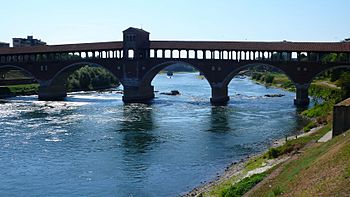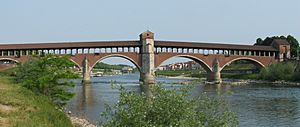Ticino (river) facts for kids
Quick facts for kids Ticino |
|
|---|---|

The river Ticino and the Old Bridge of Pavia
(medieval in date) |
|
| Countries | Switzerland, Italy |
| Physical characteristics | |
| Main source | Val Bedretto, Ticino, Switzerland about 2,200 m (7,200 ft) |
| River mouth | River Po, south-east of Pavia, Italy |
| Length | 248 km (154 mi) |
| Basin features | |
| Basin size | 7,228 km2 (2,791 sq mi) |
The Ticino river is an important river in Europe. It starts high up in the Alps mountains. This river flows through two countries: Switzerland and Italy. It gives its name to the Ticino area in Switzerland. The Ticino river is about 270 km long. It finally joins the big Po River in Italy.
Contents
Where the Ticino River Flows
The Ticino river begins in the Alps, near a place called Nufenen in Switzerland. From there, it travels south. It flows through the Ticino canton, which is a region in Switzerland.
Journey Through Lake Maggiore
A cool fact about the Ticino river is that it flows right through Lake Maggiore. This is a large lake located on the border of Switzerland and Italy. The river enters the lake on one side and leaves it on the other.
Entering Italy and Joining the Po
After leaving Lake Maggiore, the Ticino river continues its journey into northern Italy. It flows through flat lands and eventually meets the Po River. The Po River is the longest river in Italy. The Ticino joins it near the city of Pavia.
How People Use the Ticino River
The Ticino river is very useful for people living along its banks. It helps with two main things: making electricity and watering farms.
Making Electricity in Switzerland
In Switzerland, the river's water is used to make electricity. Big walls called dams are built across the river. These dams hold back the water, creating a reservoir. When the water is released, it flows through turbines. These turbines spin and create clean energy for homes and businesses.
Watering Farms in Italy
When the Ticino river reaches Italy, its main use changes. Here, it is mostly used for irrigation. This means the river water is directed through channels to water crops on farms. This helps farmers grow food, especially in the dry summer months.
Images for kids
-
The upper Ticino near Airolo
See also
 In Spanish: Río Tesino para niños
In Spanish: Río Tesino para niños




